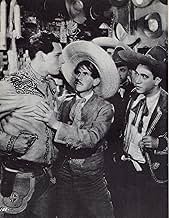Aggiungi una trama nella tua linguaA "comedia ranchera", where two good friends fall in love with the same girl.A "comedia ranchera", where two good friends fall in love with the same girl.A "comedia ranchera", where two good friends fall in love with the same girl.
- Premi
- 1 vittoria e 1 candidatura in totale
Carlos López
- Florentino
- (as Carlos López 'Chaflán')
Manuel Noriega
- Don Rosendo
- (as Manolo Noriega)
Lucha María Ávila
- Cruz niña
- (as Lucha Avila)
Trío Tariácuri
- Trío
- (as Trío Tariácuris)
Trama
Lo sapevi?
- QuizThis film's initial USA telecast took place Friday 15 November 1939 on New York City's pioneer experimental television station W2XBS, which would not be granted full time commercial status until 29 June 1941 as WNBT (Channel 1).
- ConnessioniReferenced in De noche vienes, Esmeralda (1997)
Recensione in evidenza
Known in Spanish as "Allá en el Rancho Grande," this is an iconic Mexican film that launched the genre of Ranchera movies, which were wildly popular through the 1940's. These movies idealized rural life, and presented melodramatic tales about young lovers. Typically, the male protagonists are charros (fancy dress Mexican cowboys) who sing songs and fight hard, in the name of their masculine honor.
IMDb classifies this movie as a comedy, which it is not. The confusion probably springs from the fact that Allá en el Rancho Grande is usually classified by Mexican and U.S. Academics as a 'Comedia Ranchera.' Technically, the humor here is secondary to the songs and the melodrama, so perhaps it would be more accurate to refer to this movie as a melodrama in the Ranchero genre. Debates aside, don't expect the movie to be a comedy, although it has humor in it.
This original version, directed by Fernando Fuentes, who was arguably the greatest Mexican director of the 1930's (El Compadre Mendoza, El Prisionero 13, and Vámonos con Pancho Villa are masterpieces), is MUCH better than the 1949 remake starring Jorge Negrete. I say this with all due respect to the iconic stature of Negrete, a beloved Mexican star. The actors in this movie are younger, fresher, and more realistic. There's something shopworn about the later version-- everyone seems older than they should be, and less likable.
I love the embroidered Charro shirts worn by the actors in this movie.
IMDb classifies this movie as a comedy, which it is not. The confusion probably springs from the fact that Allá en el Rancho Grande is usually classified by Mexican and U.S. Academics as a 'Comedia Ranchera.' Technically, the humor here is secondary to the songs and the melodrama, so perhaps it would be more accurate to refer to this movie as a melodrama in the Ranchero genre. Debates aside, don't expect the movie to be a comedy, although it has humor in it.
This original version, directed by Fernando Fuentes, who was arguably the greatest Mexican director of the 1930's (El Compadre Mendoza, El Prisionero 13, and Vámonos con Pancho Villa are masterpieces), is MUCH better than the 1949 remake starring Jorge Negrete. I say this with all due respect to the iconic stature of Negrete, a beloved Mexican star. The actors in this movie are younger, fresher, and more realistic. There's something shopworn about the later version-- everyone seems older than they should be, and less likable.
I love the embroidered Charro shirts worn by the actors in this movie.
- chrisconway-16046
- 23 giu 2015
- Permalink
I più visti
Accedi per valutare e creare un elenco di titoli salvati per ottenere consigli personalizzati
Dettagli
- Data di uscita
- Paese di origine
- Lingua
- Celebre anche come
- Out on the Big Ranch
- Luoghi delle riprese
- Aziende produttrici
- Vedi altri crediti dell’azienda su IMDbPro
- Tempo di esecuzione1 ora 35 minuti
- Colore
- Mix di suoni
- Proporzioni
- 1.37 : 1
Contribuisci a questa pagina
Suggerisci una modifica o aggiungi i contenuti mancanti

Divario superiore
By what name was Allá en el Rancho Grande (1936) officially released in Canada in English?
Rispondi























